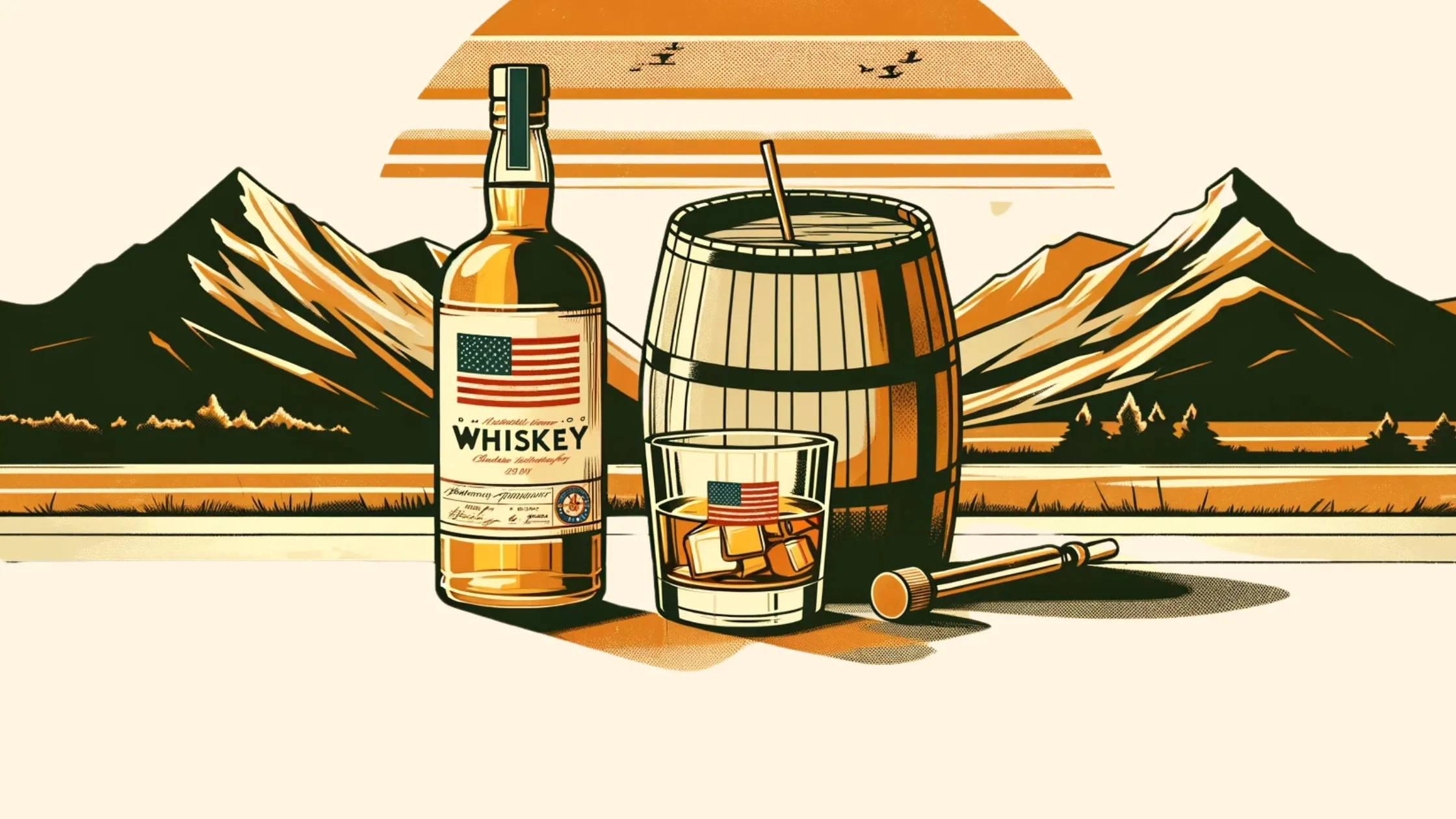There are many different types of whiskeys all over the world, but American whiskey is a distinct category in its own right.
American whiskey is a vibrant part of American culture, showcasing the country’s agricultural richness and distilling expertise. The diversity and originality of American whiskey mirrors the rich tapestry of the United States itself.
The most renowned types are Bourbon whiskey and Tennessee whiskey, with famous examples like Jack Daniels and Jim Beam. However, the American whiskey family includes a variety of other styles such as Malt whiskey, Rye malt whiskey, Rye whiskey, Corn whiskey, and Wheat whiskey.
Each type of American whiskey has unique characteristics, production rules, history, and ideal food pairings. We’ll explore these details, and more, down below.
Types of American Whiskey
American whiskey encompasses a spectrum of distinctive spirits, each bound by specific production standards.
- Bourbon, recognized globally, mandates a mash of at least 51% corn and aging in new, charred oak barrels, which bestow its iconic sweetness and full-bodied flavor. In 2020, bourbon made up 50.3% of all whiskey sales in the United States
- Tennessee whiskey, often paralleled with bourbon, undergoes an additional step — the Lincoln County Process — where it is filtered through charcoal, enhancing its trademark smoothness.
- Corn whiskey, primarily corn-based, often exceeds 80% corn in its mash. It’s unaged or aged in used barrels, offering a sweet, mild flavor with a simple, robust character.
- Rye whiskey, the use of a predominantly rye grain mash imparts a sharper, more spicy character, appealing to those who favor intensity in their sip.
- Rye Malt Whiskey, crafted primarily from malted rye, delivers a unique fusion of the sharp spiciness of rye and the smooth, rich undertones from malting, creating a complex flavor profile for the discerning palate.
- Malt Whiskey, predominantly made from malted barley, is a nod to traditional Scottish whisky-making techniques, offering a rich, nuanced flavor with a smooth finish, a testament to the versatility of American whiskey-making.
- Wheat Whiskey, utilizing a majority of wheat in its mash, is known for its exceptionally smooth and mild profile, presenting subtle, soft flavors that make it a gentle introduction to the world of American whiskeys.
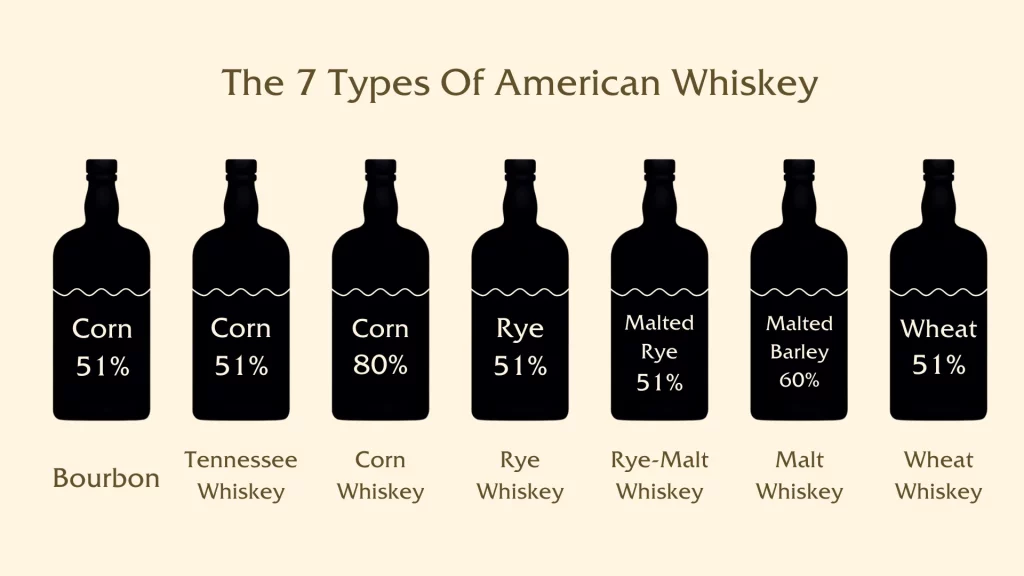
What Distinguishes Bourbon from Other Whiskeys?
What makes Bourbon unique? Bourbon has unique properties and is characterized by specific legal standards. Central to its identity is the use of at least 51% corn in its mash bill, which lends a distinctive sweetness to the spirit. Unlike other whiskeys, Bourbon must be matured in new, charred oak barrels, a requirement that imparts the classic vanilla and toasty caramel notes.
Bourbon’s distillation process is also tightly regulated. It must not exceed 160 proof during distillation and must be barreled at no more than 125 proof, preserving its rich and full flavor. While often associated with Kentucky, Bourbon can be produced anywhere in the United States, provided it adheres to these rules.
Furthermore, its purity is protected by prohibiting any additives, ensuring that its complex flavors are naturally derived from the grains, fermentation, distillation, and aging processes. These stringent guidelines set Bourbon apart as a distinct and esteemed category within American Whiskey.
Tennessee Whiskey’s Unique Filtering Method
Tennessee Whiskey is celebrated for its distinctive filtering method, the Lincoln County Process, which is a defining characteristic that separates it from other American whiskeys. During this process, the distilled whiskey is meticulously filtered through a thick bed of maple charcoal before it is aged, a step that is mandated by law for the spirit to earn the Tennessee Whiskey designation.
This charcoal mellowing not only refines the whiskey, enhancing its smoothness, but also plays a crucial role in removing any impurities, leading to a cleaner and more refined taste. The marriage of this unique filtering process with the traditional aging in new charred oak barrels bestows upon Tennessee Whiskey its rich flavor profile, marked by a signature smoothness and mellow character that is revered by whiskey enthusiasts.
Regional Varieties of American Whiskey
Kentucky is synonymous with Bourbon, famed for its limestone-filtered water and distinct seasonal temperature swings that are ideal for aging whiskey. Tennessee Whiskey is set apart by the Lincoln County Process, a method of charcoal mellowing that ensures a notably smooth finish.
Historically, regions like Pennsylvania and Maryland have been celebrated for their Rye Whiskeys, known for their spicier flavor profiles compared to the sweeter Bourbons of Kentucky.
Beyond these whiskey strongholds, an array of other states are carving out their niches. Indiana’s rye-forward spirits, New York’s bold innovations, and Texas’ climate-influenced profiles showcase the expanding variety of American Whiskey. Each region’s specific conditions and craft techniques are creating a rich tapestry of flavors and styles in the American whiskey landscape.
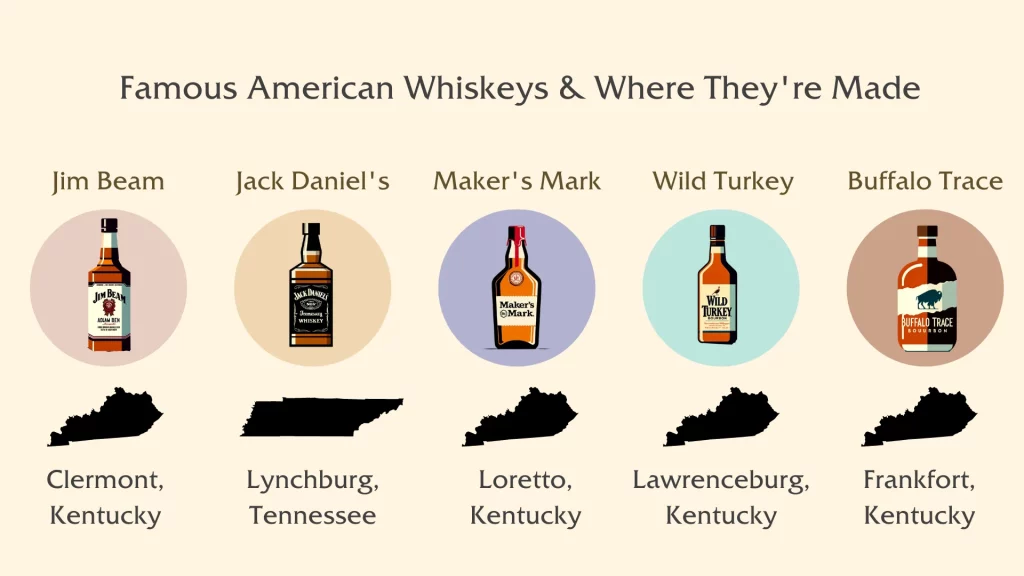
The Rich Flavor Spectrum of American Whiskey
American whiskey’s flavor spectrum, as varied as its history, ranges from sweet vanilla and caramel to assertive oak and bold spices. These flavors, born from precise grain selection and aging, narrate America’s whiskey legacy in every sip.
Signature Flavor Notes in American Whiskey
American whiskey captivates with flavors from creamy vanilla to rich caramel, sturdy oak, and lively spices. These signature notes define the whiskey’s allure, offering complexity and depth that entice the palate and showcase its unique character.
Influence of Grain Bill on Flavor
The grain bill in American whiskey sets the foundational taste. Each grain choice contributes distinct flavors, shaping the whiskey’s initial character. This selection process is crucial, as it determines the primary flavor profile that evolves during aging.
The Role of Aging in Flavor Development
Aging is pivotal in defining American whiskey’s flavors. The aging conditions—from the type of barrel to the duration and environment—refine and accentuate the whiskey’s character. This process adds layers of complexity, resulting in a bold and intricate flavor profile.
Pairing American Whiskey with Food
Pairing American whiskey with food is an exploration of taste, enhancing the dining experience. The right combination can elevate both the drink and the dish, creating a memorable culinary journey.
Complementing Flavors in Savory Dishes
Pairing American Whiskey with savory dishes is about finding a balance that enhances both. Smoky whiskeys like Bourbon, with sweet caramel notes, are perfect with barbecued meats, while Rye’s bold spiciness pairs well with robust, savory tastes. The key is matching the whiskey’s intensity and flavor profile with complementary foods, ensuring a harmonious combination that enhances the overall dining experience.
Complementing Flavors in Sweet Dishes
When it comes to desserts, the inherent sweetness in corn-based whiskeys like Bourbon can bring out the nuanced flavors in various sweet creations. Aged whiskeys with a velvety texture complement the richness of fatty meats and creamy desserts alike. This careful selection of whiskey and food aims to create a delightful interplay of flavors and textures on the palate, turning each meal into a layered sensory journey.
Which American Whiskey Should You Try First?
Discover the perfect American whiskey for your palate, from smooth Tennessee varieties to bold Rye and rich, sweet Bourbons.
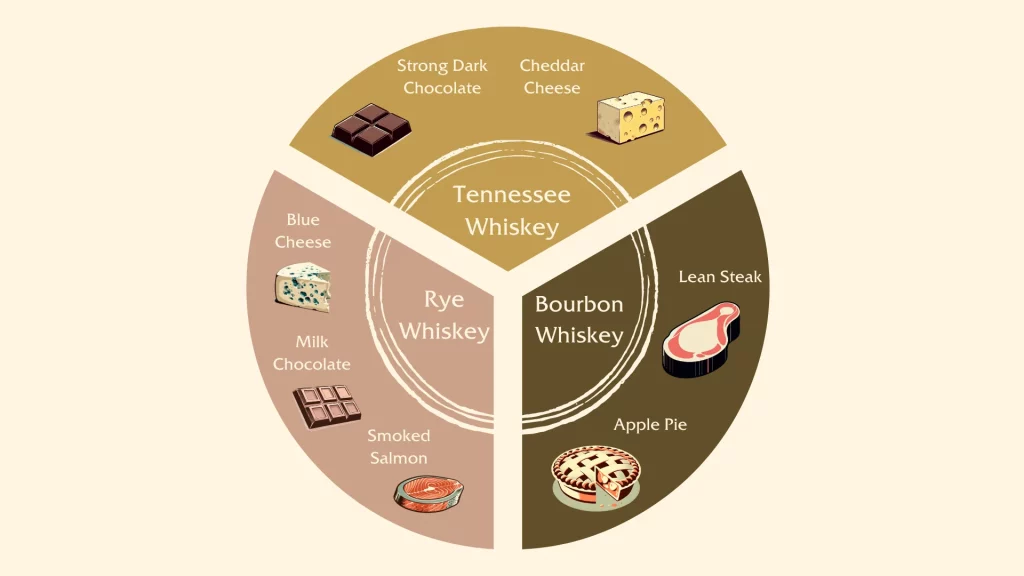
For Those Seeking Gentle, Smooth Flavors
If you’re inclined towards a gentler, smoother whiskey experience, Tennessee whiskey is a perfect start. Jack Daniel’s, a classic example, offers a mellow profile with subtle hints of caramel and a light smokiness. The Lincoln County Process, involving charcoal filtering, ensures its renowned smoothness. This whiskey type is ideal for newcomers or those who prefer their spirits less intense and more approachable.
For Enthusiasts of Bold, Spicy Notes
For those who appreciate a whiskey with robust and spicy flavors, Rye whiskey is the go-to choice. Bulleit Rye, for instance, showcases this style with its sharp, peppery notes and underlying fruitiness. The high rye content delivers a distinctively bold taste that stands out, particularly in cocktails. It’s perfect for those who enjoy a spirited whiskey with depth and a spicy kick.
For Lovers of Sweet, Rich Profiles
Bourbon is the ideal selection for those who favor a sweet and rich flavor profile. A Bourbon like Maker’s Mark, known for its smoothness and well-balanced taste, features vanilla and caramel notes, derived from its corn-dominant mash bill. Its full-bodied sweetness, coupled with a touch of oak, makes Bourbon a favorite among those who enjoy a richer, more indulgent whiskey experience.
The Unique Regulation Requirements Of American Whiskey
American whiskey regulations differ significantly from other countries, emphasizing unique production methods and quality. Unlike Scotland, American whiskey must age in new, charred oak barrels, creating richer flavors.
In contrast to Irish whiskey’s flexible distillation strength, American whiskey has strict alcohol content limits: distilled below 80% ABV, aged under 62.5% ABV, and bottled at least 40% ABV. The grain composition, like Bourbon’s 51% corn minimum, contrasts with Canadian whisky’s varied blends.
Geographical indications, such as the Lincoln County Process for Tennessee whiskey, highlight regional uniqueness, akin to Japanese whisky but with more prescriptive production methods. These regulations ensure American whiskey’s distinctive character and heritage.
Deciphering American Whiskey Labeling Terms
Understanding the labeling terms on American whiskey bottles is crucial for selecting a spirit that aligns with your taste and quality expectations. “Straight whiskey” guarantees a product aged for at least two years and free from any added colors or flavors, reflecting a commitment to authenticity. A “blended” whiskey indicates a mix of different types, offering a balance of flavors.
Meanwhile, “single barrel” selections suggest a unique profile from a specific barrel, highlighting the individuality of each batch. Recognizing these terms empowers consumers to navigate the complex landscape of American whiskey with confidence, ensuring a satisfying and tailored drinking experience.
History of American Whiskey
Globally, whiskey has had a very long and storied distillation history. Yet, the history of American whiskey embodies the unique cultural essence of the United States. Originating in the colonial era, it has mirrored the nation’s evolution. Distinct varieties like Bourbon, Tennessee, Rye, and Corn whiskey each narrate the American story of resilience and pride.
Early Colonial Roots and American Identity: A Deeper Exploration
The story of American whiskey begins in the colonial era, a time when the nation’s identity was just taking shape. Early settlers brought distillation techniques from their homelands, adapting them to the new world’s resources. This era was not just about survival but also about establishing a cultural footprint. Distilleries became a cornerstone of colonial communities, reflecting the settlers’ resourcefulness and ingenuity.
Corn, abundant in the Americas, became a primary ingredient, giving birth to a distinct spirit that would evolve into modern Bourbon. These early whiskeys were more than spirits; they were a symbol of American adaptability and the burgeoning sense of a distinct American identity.
The Prohibition Era’s Lasting Impact: An In-depth Look
Prohibition, lasting from 1920 to 1933, was a defining moment for American whiskey. This period of alcohol prohibition under the 18th Amendment was a response to social and political pressures of the time. However, it inadvertently fostered a culture of bootlegging and speakeasies, underscoring the American spirit of defiance. The repeal of Prohibition with the 21st Amendment was not merely a legal reversal, it marked a societal shift.
Post-Prohibition, the whiskey industry faced stringent regulations, reshaping production and distribution methods. This era also instilled a sense of nostalgia and reverence for pre-Prohibition whiskeys, influencing contemporary production and marketing strategies. The resilience of the whiskey industry during this tumultuous time is a testament to its integral role in the American cultural fabric.
Comparing American Whiskey To Other Whiskeys
The whiskey market is a fully global enterprise, surpassing USD 67.6 billion in 2023. Explore the unique characteristics that set American whiskey apart from Canadian, Scottish, and Japanese varieties, each with its distinct flavors and production methods.
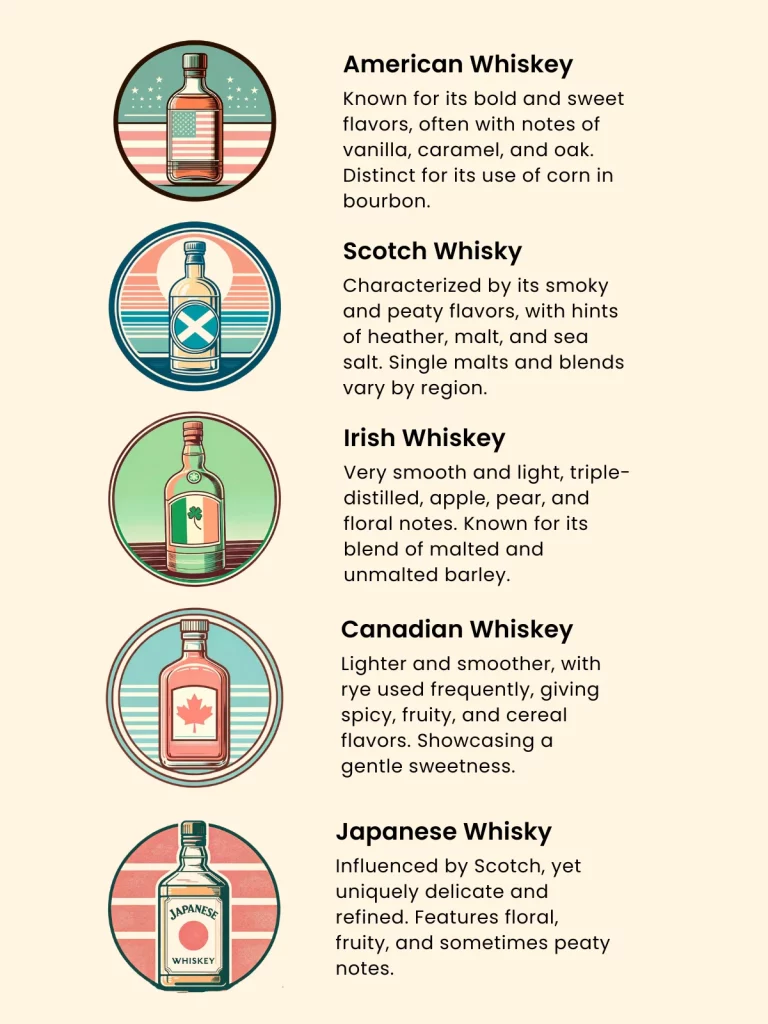
American Whiskey vs Canadian Whisky
American whiskey, especially Bourbon, is known for its bold flavors and strict production rules, like using new charred oak barrels. Canadian whisky, is often smoother and lighter, allows a mix of grains and often ages in used barrels, resulting in a more diverse flavor profile that’s typically gentler and less sweet compared to its American counterpart.
American Whiskey vs Scotch Whisky
In the comparison of American whiskey vs Scotch whisky, the contrasts are striking. While Scotch whisky emphasizes malt and peat, often delivering a smokier, earthier taste due to its double distillation and aging in used barrels, American whiskey, particularly Bourbon, is dominated by corn, resulting in a sweeter, fuller flavor. This difference in ingredients and production methods gives Scotch its signature robust smokiness, while American whiskey offers a generally sweeter, oak-infused profile.
American Whiskey vs Irish Whiskey
In the comparison of American whiskey vs Irish whiskey, the differences are clear. Irish whiskey is known for its lighter, smoother profile, often triple distilled and made with a blend of malted and unmalted barley. On the other hand, American whiskey, particularly Bourbon, stands out due to its high corn content, giving it a richer, sweeter character. These contrasting ingredients and distillation processes highlight the divergence between the approachable, delicate nature of Irish whiskey and the bold, sweet flavors of American whiskey.
American Whiskey vs Japanese Whiskey
American whiskey, with its bold and sweet flavor profile from corn-based mash and new barrel aging, differs from Japanese whisky, which often emulates the Scotch style. Japanese whisky is known for its precision and balance, often featuring a subtler and more refined profile, with less emphasis on the overt sweetness found in many American whiskeys.

